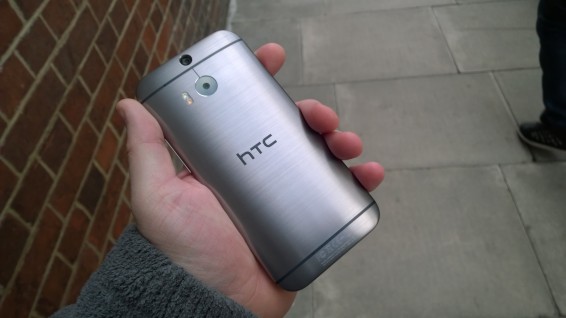We were at the HTC event in London today and, with the press area so busy and loud, we really couldn’t get proper shots. Luckily enough we were given a handset to take away and review for the next few weeks.
The device was announced and available on the same day. Really impressive, and we have all the details from the various networks on pricing too.
You can get all the HTC One features and the specifications in our earlier post, plus you can hear my thoughts in this weeks’ Coolsmartphone podcast.
Check out how the device compares to the earlier version too.
On the back is the most-touted feature – the brand new twin camera with a dual LED flash. This should make for some fantastuc photos as it has a depth sensor and a lot of on-board effects.
The dual LED flash helps with poor lighting conditions but that is something the ultrapixel lens on the One M8 can handle very well on it’s own too. This is one of the major advantages of ultrapixels over megapixels.
The camera on the back is the same as seen on the last years model – 4 ultrapixels. This is more than enough for sharing photos on social media sites such as Facebook and Google+.
Where the M8 will struggle is, once again, convincing the general public that a 4 ultrapixel camera is better than 16 megapixels on the S5 or 20.7 megapixels on the Z2. Both of these high-end competing handsets are available next month and are flagship models. Samsung in particular will be spending quite a bit on advertising to make sure you know about that S5.
Where the M8 is unique is the second camera on the back. This allows for some really nice special effects like blurring the background and focusing on the foreground. It’ll make your main object really stand out.
You can even reverse that and blur what is in front and focus on the background if you want.
On the right side you have a MicroSD card slot (do not mix this up with the SIM card slot!) and this supports the new larger 128GB storage cards. It’s great to see the return of the microSD and is something that was missing on the original HTC One.
Here you can also find the volume up and down keys which can be used in settings for a camera shutter. This is due to the simple fact that there is no dedicated key like on the Z2 from Sony.
On the left side you just have a single SIM card slot with a pin hole to push out the tray. It’s a Nano SIM slot – yes the M8 takes a Nano SIM!
The reason the slot is larger than before is that there is due to be a dual-SIM version for certain markets. We hear that this will fit the other Nano SIM too.
At the top you have the power button, which is obviously used for turning the phone on and off. There’s also the IR blaster used with the SenseTV app once again. It’ll let you control your TV or Cable/Sky box etc. The new updated app lets you get updates on sports results and is far more “social friendly” than the previous version.
At the bottom is the MicroUSB port for charging or moving those photos and videos to a computer.
You also have the 3.5mm headset jack on the bottom, which some people will like. Personally I don’t like the position here and prefer it up top but that is more of a personal preference.
The screen on the M8 is 5 inches, which is larger than the 4.7 inch seen on the original HTC One. This makes for a better viewing experience when checking out photos and video playback.
A larger screen also allows for better web browsing too and, with a 1080p resolution, you’re getting a seriously good screen in a phone that does not feel too big either.
At the top is the larger BoomSound speaker that is 20% louder. Those speaker chambers have been redesigned to give you a clearer sound than the previous model.
You also have the light sensor and the 5 megapixel camera which also has HDR. It’s a wide angle lens and also records video in 1080p. This is the perfect phone for anyone wanting to get into video blogging or taking a selfie.
At the bottom of the screen is the HTC logo. Notice there are no back or home buttons on here any more. All the buttons are now on screen, so they’re only when you need them.
You also have the second BoomSound speaker for very loud and clear audio, the original M7 speakers were pretty decent and very loud, but these will be even better with the new technology.
This was just a brief overview of the M8, we only had hands on it for a short time today and will be putting our review unit through it’s paces over the next 2 weeks bringing you lots of video content plus sample photos from the camera and much more information.


